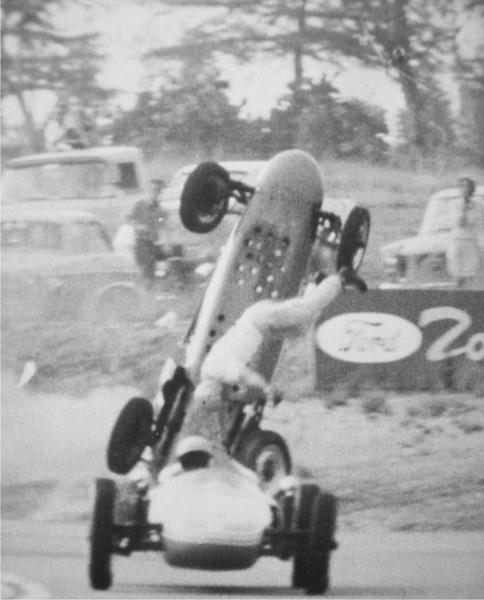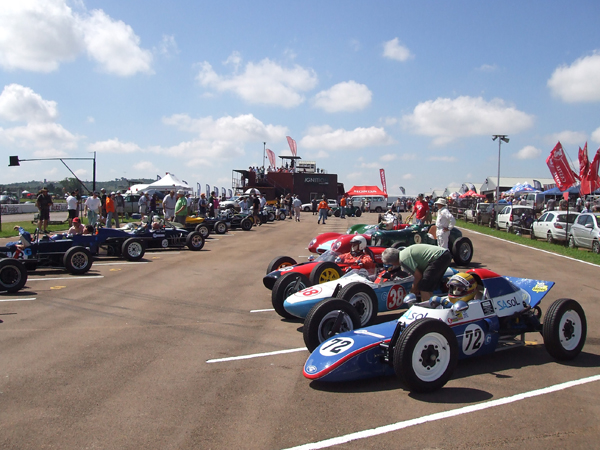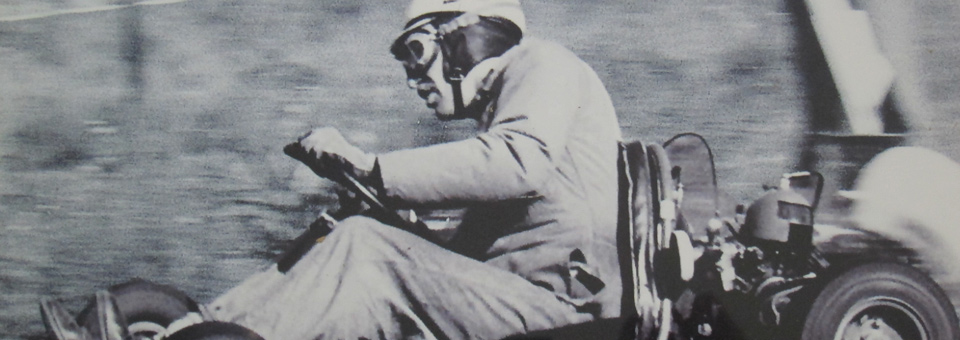The dream of racing started at an early age for John Kernick, as many weekends were spent next to the East London race track with his father, who not only worked for Dunlop at the time, but also planted the first seeds for his son, grandsons and great grandsons’ racing passion.
John made his dream of racing a reality in 1958, when he and a friend built their first go-kart. Because of their height difference and the fact that they shared the same kart, it was decided to move the foot pedals to the nose of the kart in front of the tie rods, unlike all other karts of that era, which positioned their pedals behind the tie rods. The kart wasn’t the only thing that they shared. Early days and empty pockets forced them to borrow a helmet on race days from their local delivery man.

John enjoyed racing so much that he stepped it up a notch, and a decade later, bought his first Formula Vee. This caused some upset in the Kernick household. Mrs. Kernick had her hopes set on a new sewing machine for the family, but John had other ideas and thought it wise to spend the R900 on a Capital Vee.
The birth of Formula Vee in South Africa took place at Kyalami in May 1965, when three Formula Vees took to the track at a club meeting. It was soon realized how affordable and exciting formula Vee racing was, and many future legendary drivers started grinding their teeth in these 1300cc single seaters. For the first 2 years 1200cc beetle motors were used. Tony Jeffries took FV racing to new heights in 1967. He won South African FV championship and as part of his prize received a plane ticket to the Bahamas and the opportunity to compete in the Formula Vee World Championship. He won the 200 mile long race and became world champ in his Capital Vee built by Capital Motors, a Volkswagen dealership in Pretoria.

As previously mentioned, John bought the nr. 12 Capital Vee the following year from George van Straaten. This might not be the car that Jeffries won his world championship in, but it’s equally rich in history. Jeffries’s car was bought by an American car enthusiast, Bill Robinson, after the Championship. Jeffries was asked to race it at Daytona and other races in the USA. Incidentally John’s car is believed to be the only Capital Vee left in South Africa today, with only six of these early Vees built by Capital Motors. Werner Alker, who was part of the team in 1965, recalled how the nr. 12 car made its debut. Capital Motors was in healthy competition with their neighbours, Peco Motors in those days and what better way for a dealership to prove the quality of their product than on the race track. The only problem for Capital Motors was that Peco had two cars, and thus the upper hand. Capital Motors answered back by secretly building a second car in record time. Seven days later the nr. 12 car rolled onto the grid to neutralize the competition.

It wasn’t always smooth racing and on 22 January 1966 the nr. 12 car was involved in the famous Fanie Viljoen accident. This however didn’t stop it from racing. From 1968 John enjoyed his air cooled wonder with its white and blue colours and 38 number and finally sold it in 1970. For the next 18 years the Kernick family parted ways with this special Formula Vee. At the 21st anniversary of Formula Vee racing in South Africa, the Kernick family were invited to relive some of their great memories. John once again got the chance to drive his old Vee, now sporting red and black colours and the number 57, while his three sons Peter(1985 FV National Champ), Bruce and Alan(who missed the title by half a point in 1989) drove other historic Vees from that period. Peter appeared in his Herrier Vee (championship winning and co-designed with Mike Frankle), while Bruce raced the Bolzup Vee (a Tony Beukes design). Alan completed the family trio, by competing in his self build Tasman (the name adopted after writing off the original Ray Bromley designed Tasman at Kyalami).

In 1998 the Kernick’s reunited with this special car, which by now had moved from one tree to the next awaiting restoration. Sadly John passed away in 1999. As a tribute to his dad Alan restored the car back to his father’s racing days. Alan explains how he was only planning on the car driving at the 35th anniversary in memory of his dad, by John’s good friend, Terry Stidworthy. Air cooled Vees were something of the past as stronger VW golf motors were used by now. Not all was lost, as Alan realized that historic racing was becoming popular once again. The Parade lap turned into Historic racing on the weekends in the years that followed.

Another diamond in the Kernick collection is a Witter Formula Vee that was built in 1972 by Joseph Witter and his daughter Judy. This Sasol sponsored Vee with racing number 72 (as in the year it was built) won the National Championship for FV in 1973 with Judy at the wheel, showing experienced male drivers how it’s done. A lot of controversy surrounded this championship win and Judy was only, rightfully, given the trophy in 1974 and her name was finally added to the record books.
These Formula Vees have changed owners, colours and numbers several times in the last 4 decades of racing, but it is safe to say that their future is in good hands and the memory of a man and his nr. 38 car lives on.


Historic racing at Zwartkops

A very special day. Werner and Alan meet for the first time and share their memories.

Werner dreaming of early days.


Foot pedals in front of the tie rods. This was unheard of in 1958 and ahead of it’s time by 10 years.

The original tyres on the go kart from 1958

Photos: Viljoen collection, Kenrick collection and Aircooledwonders.com











I have just been sent this link by my son in the UK.
I do not know who this belongs to but I will be forever indebted to Alen Kernick after seeing the reswtoration of my Eagle LSR01 earlier this afternon.
The hard work that Alan is putting into ensuring that the SPIRIT of Air Cooled Formula Vee in South Africa lives on is tremendous. Alan continues to be a credit to the formula.
Thanks so much Alan for rekindling the memories.
Historic motorsport in it’s pure and honest form would not be where it is today without people of the calibre of Alan Kernick. The vaste majority will build/rebuild a car to a spec that’s improves their chances of winning rather than back to original spec.
As Alan so clearly demonstrates, historic motorsport,s
raison d’etre is the celebration of the cars, not winning races.
Well Done Alan.
Alan Kernick together with brother Peter epitomise evrything that is valued by the historic racing fraternity; ethics, honesty & enthusiasm.
With them at the helm the “air-cooled” segment of SA historic restoration & preservation can only go from strength to strength.
They are an example & an inspiration to all of us!
Thank you guys.
From 1972 i drove my home built Vee and in late 1974 and the 1975 season I drove the second Witter Vee. During this time I had the pleasure of knowing John Kernick – a thorough gentleman. It is very heartening to see his sons continuing the family involvement with Vees. I raced in other Formulae and can vouch for Formula Vee being the most competitive and sportsmanlike formula. I often tell the story of Floyd Peterson with whom I was competing for the 1975 title, stopping me as I was about to go onto the track because he could hear that my inlet manifold was loose. He tightened it while I sat in my car & we then went out and raced each other. In what other formula would you find such sportsmanship? Thanks for the opportunity to comment. I also have some old programmes & newsletters that I’ll post. I spent some time writing them in the days when Beulah worked for the SCC & typed them for us.
Derek
Thank you for sharing your experiences of Formula Vee with us. I am fascinated with the early racing days we had here in SA. It was true racing, with real cars and as you said, sportsmanship and respect was at the order of the day.
Wernher
Does anyone remember what happened to the original hand built Formula Vee built by my father Romolo Fonto then working for SAA and a pilot friend (cannot remember his name)of his in a garage in Kempton park. I helped him over many weekends building and shaping this aluminum body. The panels were riveted together and I remember a hand made steering wheel from stainless steel and wood sandwiched and riveted together.
The back looked like a Classic Bugatti/Alfa of the 50’s. This must have been about 1961/2. I heard much later that this body had been used as a mould to make fibre glass bodies…Capital Motors rings a big bell.
I dont have any pictures and would love to get hold of some if it still exists.
Giancarlo Fonto, Please write to Peterk@fastdeck.co.bw, if he cannot help, AJ or Bruce might be able to assist.
Regards
Hi Guys, Sounds like a project Meyer Both could have been involved with. I have no immediate recall of the name Romolo Fonto, but Kevin K might as he has a list of + 400 FV drivers. Unfortunately most of the EX FV drivers who would have known are no longer with us. A clue would be Geoff Thorton’s partner in Firecall as they were both instrumental in building the first very narrow Mantis. I need a trigger to remember his name. 1961 is too early as the first FVs were only built in1963 in the USA and in SA, in the late 1964/early 1965. I first heard of FV at the Burman Drive Hill Climb in 1964 when a VW pan without body but a couple of hoops to hold things together competed and the commentator wondered if this was the newly talked about FV. Regards Terry
My nsme is Horst Ihwe, a formula Vee Driver
from 1965 to 1970. My car was the first one to
be ready in 1965. I still have plenty of Fotos
from the beginning of formala Vee in SA.
I´m nearly 80 years old by now and live back in Germany since 1972. If interess please
wright.
horst ihwe, kiel, Germany